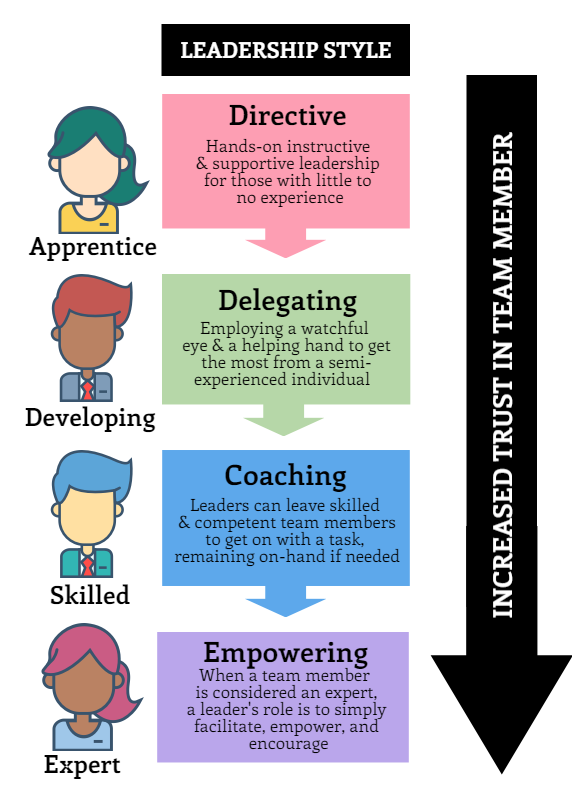- Mike Titchen
- May 26th, 2016
Even in good times, managing others can be difficult. The role gets even harder when times are tough; implementing unpopular policies, making significant changes, or confronting an awkward or aggressive individual. To tackle such tasks, managers often formulate their own unique leadership styles. However, there is a tendency to apply this preferred style regardless of the varying ability and experience of team members. This one-size-fits all approach has ignited frustration and conflict in workplaces the world over.
Only a fortunate few have avoided the controlling watch of a micromanager during their career. Such leadership style causes a constant state of apprehension as they stand looking over shoulders and refusing capable employees the freedom they are crying out for. Conversely, other leadership styles leave employees feeling frightened and helpless as their boss sets tasks way beyond their skill level. Such cases of misjudged leadership style can have a seriously negative impact on both the individual and the company.
A successful leader should be able to identify the level of individuals, and adapt their own management style accordingly. For some, leadership comes naturally, but for many it’s trial and error. For this reason, there are many management models to lean on until you can stand as a strong leader.
Which Model to choose?
The model I recommend is a simplification of Blanchard’s Situational Leadership Model. I call it, Adaptive Leadership.It recognises four basic Leadership styles: Directing, Delegating, Coaching, and Empowering. It matches these styles to the team member’s degree of technical competence and the level of trust the leader has in them.
The Adaptive Leadership model in action
Directing the Apprentice:
Imagine your 9-year-old daughter has asked to bake for the very first time. In this situation, where your child has no experience at all, she is classed as an apprentice role and so the model would recommend you take a directive style.
This leadership style is not aggressive or commanding, but instructional and supportive. You need to show her every step of the way. As you help your daughter weigh out the ingredients, you explain the importance of the right measurements. When you allow her to turn on the oven, you emphasise the dangers involved. Although this may feel as though you are almost making the cake yourself, you are preparing your daughter with the skills and knowledge to eventually bake independently.
Delegating to the developed:
Your daughter has now baked several cakes under your directive guidance. Her skills have developed and your confidence in her ability has increased. She is now a developed baker, and so the model suggests you take a delegating role.
So, the next time she approaches you to bake a cake, you ask her to find a suitable recipe and method, along with a list of the things she thinks she must be cautious of. You then go through this with your daughter before allowing her to bake on her own. The independent selection of the recipe and devising of a list, demonstrates that she has enough competence and confidence to go it alone. At this stage, you will still keep a very close eye on her and be on hand to assist if necessary.
Coaching the skilled:
Several months have passed, packed with birthday cakes and bake sales, and now your daughter is eager to push herself to take on new challenges. Although she makes the occasional mistake, she can cope with most difficulties and is considered a skilled baker. It is now appropriate for you to adopt a coaching style of leadership.
At this stage, all you need to do is offer the occasional piece of advice and make it clear that you are available for support or guidance.
Empowering the Expert:
Several years later, your daughter announces that she is considering applying for the Great British Bake Off competition. She is now very experienced and is widely considered an expert baker amongst family and friends. It is now time to adopt the empowering leadership style.
Your role is to enthuse and encourage your daughter. You simply express your full support, point her in the right direction, and tell her to let you know if she needs you to break down any barriers for her.
This model is a straightforward way to create harmonious relationships between management and team members. As a manager or leader, you may even find it useful to openly discuss this model with each individual, agreeing on their level of ability together to determine the leadership style best suited to them. By also acknowledging that individuals’ abilities differ dependent on given tasks, and creating an open and honest dialogue around this, you can generate a productive and positive environment.
Eventually, you will find yourself automatically selecting the appropriate leadership style, without the crutch of the model. You will have become a natural leader, who confidently gets the most out of any team.





